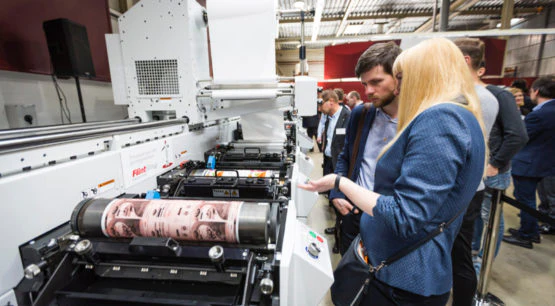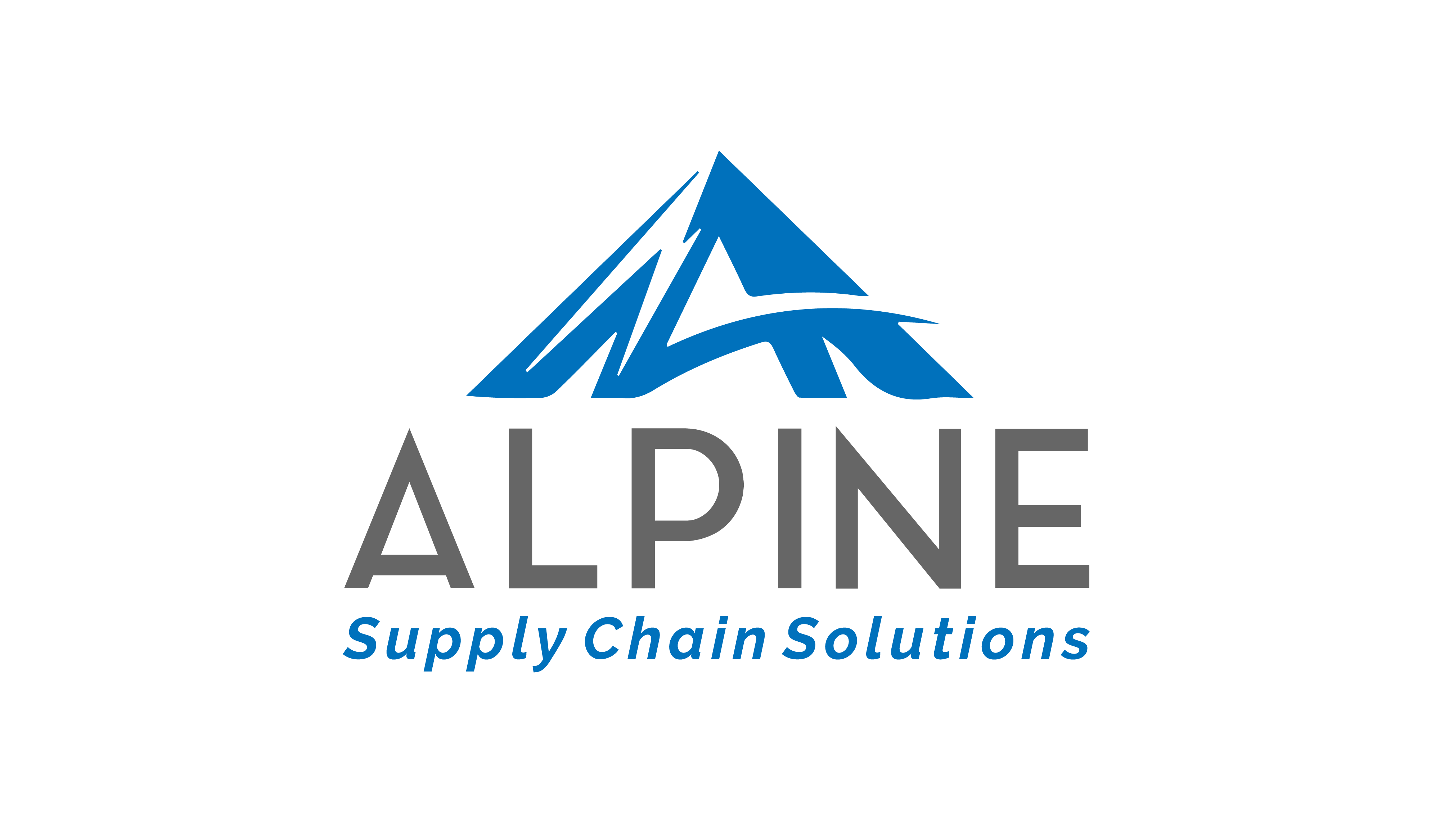
by Alpine Supply Chain | Dec 20, 2020 | 3PL
From SDC Executive: Alpine Optimizes Distribution for Mark Andy Print Products
Alpine Supply Chain Solutions completed a multi-faceted project that optimizes distribution for Mark Andy Print Products, a global manufacturer of printing presses. Alpine provided consulting services to improve space utilization, productivity, and replenishment cycle times at Mark Andy’s primary distribution center in Des Plaines, Ill., and conducted a network analysis to determine the best location for third-party logistics (3PL) facilities to facilitate next-day shipping for customers.
Mark Andy was outgrowing its 80,000-square-foot distribution center and needed to determine if 40,000 or 80,000 additional square feet was needed. Alpine conducted a storage type analysis, facility design and slotting project to create the right-sized product homes and place the right products into the best locations, maximizing space usage and improving productivity.
“Alpine has a well-rounded team that understands all aspects of supply chain operations as well as current industry standards,” said Stuart Gallup, Vice President-Commercial Market for Mark Andy. “They were able to rapidly respond to changing information in a very dynamic environment and provided the best solution at a given cost which increased our ROI.”
In addition to the warehouse optimization project, Mark Andy also recognized the need for new locations across the United States to facilitate next-day delivery. Alpine conducted a network analysis to understand where Mark Andy customers were located and to determine the ideal number of facilities and inventory levels required to provide their network with a 98% next-day service window. Alpine then conducted an in-depth RFP process and helped Mark Andy select and onboard five new 3PL locations in five months.

by Alpine Supply Chain | Jul 13, 2020 | Supply Chain Consulting, Supply Chain News, Warehouse Management System
Supply Chain Management Review and Modern Material Handling sat down with Michael Wohlwend to discuss WMS.
Modern: You’ve been around the supply chain software space throughout your career. Tell us about the different roles you’ve held.
Wohlwend: I was a warehouse distribution supply chain consultant for the first third of my career, and I installed my first warehouse management system (WMS) in 1994. That was followed by 7.5 years at Manhattan and 6.5 years at SAP. Now, I’m back to the consulting side.
Modern: Since you’ve worked in both the enterprise resource planning (ERP) and WMS spaces, what have been the most important developments during your career? We’ll start with ERP.
Wohlwend: Originally, an ERP system was finance and accounting. And then, they added manufacturing resource planning and planning. After that, ERP tried to be all things to all people and address the end-to-end supply chain. That had its limitations and opened the door for best-of-breed solution providers, especially with the Cloud.
Great examples of that are Salesforce.com for CRM and Workday for HR. Now, we see ERP companies buying Cloud-based software companies with a subscription model to offer best-of-breed solutions under the ERP umbrella. The technology is evolving.
Modern: How about the WMS space?
Wohlwend: For a time, CIOs trying to reduce their overall software footprint were getting the WMS module from an ERP provider like Oracle or SAP. In situations that weren’t complex, like pallet in and pallet out, the WMS from an ERP was good enough. Now, there’s a resurgence of WMS. The real trend I’m seeing is global manufacturers moving to a 3PL for their distribution and deferring to the 3PL’s WMS. And, most of the 3PLs will have a low-cost WMS, with less functionality, and a higher cost version. Depending on complexity, the 3PL will choose which version to roll out for their customer.
Modern: What are your clients struggling with today, particularly with WMS systems?
Wohlwend: Whenever you’re implementing a WMS, you run out of resources, time or money. So when people install a WMS, they never turn everything on because they run out of one of those three. Then, they run into an issue and don’t realize they have the functionality.
I recently went to a site that wasn’t doing directed putaway or batch picking because they’d never turned on the functionality. It cost them $52,000 and they had an ROI in two weeks. The No. 2 reason is that they business model changed. For example, with Covid-19 now they may need to turn on each picking and need to configure along with cartonization. Their WMS has the functionality but needs to be configured.
Modern: Given all the changes in fulfillment processes, what should a company do?
Wohlwend: The most common thing I see is that they didn’t turn on all the functionality, and they haven’t upgraded, so now they’re at a pivot point. Do I keep an existing system and “add on modules” like voice, labor management, or slotting modules? Or, do I rip and replace? There are companies adding “Add on Modules” on top of old versions of EXE and Catalyst.
The problem with ripping and replacing is that a lot of the new systems are in the Cloud. That sounds good, but I just worked with a 3PL that couldn’t get Internet access at their site. They had to have a server on site. And when you’re talking about an automated system that requires sub-second response times, I believe it has to be on-premise. You just can’t risk your order fulfillment system on a connection that could go down.

by Alpine Supply Chain | Jun 16, 2020 | 3PL, Distribution Network Services, Warehouse Management, Warehouse Management System
Performs Storage Type Analysis and Facility Design to right-size facility then a Network
Analysis, 3PL Selection, and onboard to support next-day delivery
Alpine Supply Chain Solutions, a leading boutique supply chain consulting firm, today announced the successful completion of a multi-faceted distribution optimization project for Mark Andy, a global manufacturer of printing presses. Alpine provided consulting services to improve space utilization, productivity and replenishment cycle times at Mark Andy’s primary distribution center in Des Plaines, IL, and conducted a network analysis to determine the best location for third party logistics (3PL) facilities to facilitate next day shipping for customers.
Mark Andy was outgrowing its 80,000-square foot distribution center and needed to determine if 40,000 or 80,000 additional square feet was needed. Alpine conducted a Storage Type Analysis, Facility Design, and Slotting project to create the right-sized product homes and place the right products into the best locations, maximizing space usage and improving productivity.

Stuart Gallup
“Alpine has a well-rounded team that understands all aspects of supply chain operations as well as current
industry standards,” said Stuart Gallup, Vice President-Commercial Market for Mark Andy Print Products. “They were able to rapidly respond to changing information in a very dynamic environment and provided the best solution at a given cost which increased our ROI.”
In addition to the warehouse optimization project, Mark Andy also recognized the need for new locations across the US to facilitate next-day delivery. Alpine conducted a Network Analysis to understand where Mark Andy customers were located and to determine the ideal number of facilities and inventory levels required to provide their network with a 98% next day service window. Alpine then conducted an in-depth RFP process and helped Mark Andy select and onboard five new 3PL locations in five months.
About Mark Andy
Mark Andy is a pioneer of the graphic arts and printing industry. As the world’s leading manufacturer of
narrow- and mid-web printing and finishing equipment, we supply leading global brands, including Mark Andy and Presstek printing presses, Rotoflex finishing solutions, as well as a complete line of Mark Andy Print Products consumables and pressroom supplies. All products are backed by the largest customer support team in
the industry, minimizing downtime and helping our customers be profitable, efficient and at the forefront of innovation. For more information, visit Mark Andy.
About Alpine Supply Chain Solutions
Alpine Supply Chain Solutions, based in Chicago, IL is a supply chain consulting company driven to ensure their clients get the most value from their investments. Their approach to every project starts with the data and ends with a cost justifiable solution. With deep roots in industrial engineering, Alpine’s approach is unique.

by Alpine Supply Chain | Jun 14, 2020 | 3PL
A recent Food Logistics article by Brielle Jaekel reviewed the increased demand for third party logistics for functional beverages. “The demand for beverages that offer nutritional value or energy is increasing at exceptional rates, and with the Coronavirus diseasee (COVID-19) pandemic limiting consumers’ trips to the grocery store and ability to dine out, this growth has only escalated. According to a report from Research and Markets, before the outbreak hit, the functional beverage sector has been poised for a compound-growth rate of 11% from 2020 to 2024. Functional beverages are any form of beverage consumed with the notion of doing something specific for the body, including energy drinks, prebiotic and probiotics, special fruit and vegetables juices, sports drinks and CBD-based drinks. Their functions can range from providing alertness and energy to anxiety reduction.”
Michael Wohlwend, Managing Principal of Alpine Supply Chain Solutions, weighs in on how 3PLs will remain an integral part of the distribution process for functional beverage brands looking to scale and get closer to their customers.

Alpine CEO Michael Wohlwend
“Given the growth and lack of historical order profiles, the unknown could result in unrealistic expectations between the manufacturer and the 3PL,” says Michael Wohlwend, managing principal at Alpine Solutions. “There will need to be a sliding scale with regard to the project, so that as the business grows and the demands grow, the 3PL can flex up to meet the demands.”
“Several 3PLs have or are about to invest in layer pick technology,” says Michael Wohlwend, managing principal at Alpine Solutions. “Rather than have a picker go to a location and pick cases of product, there are several different types of technology that allow for the picking of a layer or multiple layers of a pallet at one time.”
About Food Logistics Magazine
Food Logistics reaches more than 26,000 supply chain executives in the global food and beverage industries. The audience includes executives in the food sector (growers, producers, manufacturers, wholesalers and grocers) and the logistics section (transportation, warehousing, distribution, software and technology) who share a mutual interest in the operations and business aspects of the global food supply chain. Food Logistics, published 10 times a year, is the only magazine exclusively dedicated to covering the food and beverage supply chain, from the largest food manufacturers to retailers, distributors and food service providers. Food Logistics is an excellent source of buyers in food and beverage manufacturing, producing, processing, retailing, distributing, restaurant and food service, warehousing, transportation, and storage.

by Alpine Supply Chain | Jan 9, 2020 | Supply Chain Consulting
In the current issue of Inbound Logistics, Alpine’s Michael Wohlwend shares his thoughts on technology innovations and process insights for enhancing the value that 3PLs bring to shippers.
Many 3PLs continually invest in warehouse, transportation, and labor management systems. “Those are real-time execution systems to help plan labor and equipment and maximize space,” says Wohlwend. “Slotting optimization is also popular to support a 3PL customer’s lifecycle.” In addition, many 3PLs are looking for e-commerce capabilities.
Short excerpts from the Inbound Logistics article:
Indeed, many 3PLs continually invest in warehouse, transportation, and labor management systems. “Those are real-time execution systems to help plan labor and equipment and maximize space,”says Michael Wohlwend, managing principal with Alpine Supply Chain Solutions Consulting. “Slotting optimization is also popular to support a 3PL customer’s lifecycle.”
In addition, many 3PLs are looking for capabilities, such as the ability to pick and fill online orders and provide next-day service, that will enable them to help clients more effectively navigate a market increasingly ruled by e-commerce.
(In regards to streamlinging e-commerce): The growth of online ordering has enhanced the value 3PLs can provide. Customers’ increasing expectation of next- or same-day delivery adds to transportation complexity. Many 3PLs have gained experience in tight delivery deadlines and omni-channel distribution, and companies in other industries are leveraging that expertise.
“Companies are focusing on their core competencies and letting companies that specialize in logistics manage the distribution,” Wohlwend says.









